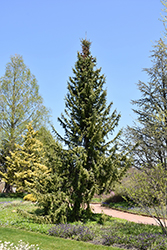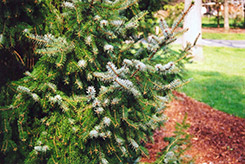Height: 60 feet
Spread: 25 feet
Sunlight:
![]()
Hardiness Zone: 4a
Description:
A tall and narrow spire-shaped evergreen with a more delicate appearance, features interesting white banding on needles which give an airy appearance from afar; very tough and adaptable, one of the more refined spruces for general landscape use
Ornamental Features
Serbian Spruce is primarily valued in the landscape for its distinctively pyramidal habit of growth. It has attractive dark green foliage with silver undersides which emerges light green in spring. The needles are highly ornamental and remain dark green throughout the winter. The smooth brick red bark adds an interesting dimension to the landscape.
Landscape Attributes
Serbian Spruce is a dense evergreen tree with a strong central leader and a distinctive and refined pyramidal form. Its relatively fine texture sets it apart from other landscape plants with less refined foliage.
This is a relatively low maintenance tree. When pruning is necessary, it is recommended to only trim back the new growth of the current season, other than to remove any dieback. It has no significant negative characteristics.
Serbian Spruce is recommended for the following landscape applications;
- Vertical Accent
Planting & Growing
Serbian Spruce will grow to be about 60 feet tall at maturity, with a spread of 25 feet. It has a low canopy, and should not be planted underneath power lines. It grows at a slow rate, and under ideal conditions can be expected to live for 80 years or more.
This tree should only be grown in full sunlight. It does best in average to evenly moist conditions, but will not tolerate standing water. It is not particular as to soil type or pH. It is quite intolerant of urban pollution, therefore inner city or urban streetside plantings are best avoided, and will benefit from being planted in a relatively sheltered location. This species is not originally from North America.
Disclaimer - This resource is provided for informational purposes only and does NOT reflect current availability. Inventory varies seasonally, so we cannot guarantee that every plant will be in stock at all times - please contact your favourite GardenWorks location directly for current availability. It does not include our entire inventory of plants, so be sure to visit GardenWorks to see varieties that may not be represented on this list.


